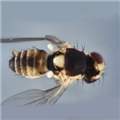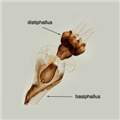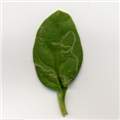
adult, lateral (L. Semeraro)

adult, dorsal (A. Ames)

aedeagus (A. Ames)

mines on silver beet (P. Ridland)
Nomenclature
Liriomyza chenopodii (Watt 1924)
Phytomyza betae Coquillett 1900 [preoccupied Macquart 1855]
Haplomyza chenopodii Watt 1924
Haplomyza imitans Malloch 1934
Spencer (1977) correctly noted that Hering (1957) accepted Phytomyza betae Macquart as being available by indication and that indication is the description of the work of an organism (Art.12.2.8 under the current code). Macquart (1855: 258) wrote: "Phytomyza Betae Macq. -- V. Houx. La larve mine les feuilles de la Betterave" � the description "mine" and the plant host is clearly a statement (indication) of the work of an organism (Chris Thompson & Neil Evenhuis personal communication). Subsequently, Spencer (1990) and Spencer & Martinez (1987) considered Phytomyza betae Macquart to be a nomen nudum but, as noted earlier, this is incorrect and so Phytomyza betae Coquillett is a primary homonym.
Hosts
This species is known only from genera from two closely related plant families: Caryophyllaceae (Cerastium, Silene, Stellaria) and Chenopodiaceae (Beta, Chenopodium, Spinaca) (Spencer 1963, 1977).
Distribution
Oceania: Australia (Australian Capital Territory, New South Wales, Queensland, South Australia, Tasmania, Victoria, Western Australia), New Zealand
Key characters
Small flies (wing length 1.6 mm). Frons, antennae, femora and scutellum bright yellow. Mesonotum blackish-grey. Orbits not projecting above eye. Orbital setulae minute, sparse. Third antennal segment rounded. Second (outer) cross-vein (dm-cu) lacking. Ejaculatory apodeme unusually wide. Posterior spiracles of larva and puparium have 3 enlarged spiracular bulbs (Dempewolf 2004; Spencer 1963, 1977).
Notes
The larvae of Liriomyza chenopodii form white linear leaf mines and pupate externally (Spencer 1977). The species is easily distinguished from L. caulophaga which can also be found on Beta (Dempewolf 2004). Mined leaves are commonly observed in southern Australia in spring (September- November) and early autumn (March-April), but the larval populations are often very highly parasitized (Bjorksten et al. 2005). In Victoria, the most common parasitoids recorded were Hemiptarsenus varicornis (Girault), Diglyphus isaea Walker and Zagrammosoma latilineatum Ubaidillah. In addition, these synovigenic parasitoid species cause additional host mortality by host feeding (Bjorksten et al. 2005). Another abundant parasitoid reared from L. chenopodii is the braconid, Opius cinerariae Fischer, which was redescribed from material reared from L. chenopodii (Belokobylskij et al. 2004). In southern Australia, common agromyzids such as L. chenopodii, L. brassicae and Chromatomyia syngenesiae (usually on Sonchus oleraceus) on weeds and other non-crop plants would act as important reservoirs for populations of parasitoids of any invasive polyphagous agromyzids.
References
Belokobylskij SA, Wharton RA & La Salle J (2004). Australian species of the genus Opius Wesmael (Hymenoptera: Braconidae) attacking leaf-mining Agromyzidae, with the description of a new species from South-east Asia. Australian Journal of Entomology 43: 138-147.
Bjorksten TA, Robinson M & La Salle J (2005). Species composition and population dynamics of leafmining flies and their parasitoids in Victoria. Australian Journal of Entomology 44: 186-191.
Coquillett DW (1900). Descriptions of two new species of Diptera from Western Australia. Proceedings of the Linnean Society of New South Wales 25: 389-390.
Dempewolf M (2004). Arthropods of Economic Importance - Agromyzidae of the World (CD-ROM). ETI. University of Amsterdam, Amsterdam. https://agromyzidae.linnaeus.naturalis.nl/linnaeus_ng/app/views/species/nsr_taxon.php?id=57040&epi=55
Hering EM (1957). Bestimmungstabellen der Blattminen von Europa einschliesslich des Mittelmeerbeckens und der Kanarischen Inseln. Dr W Junk, 's-Gravenhage. 3 Vol. 1-648, 653-1185, 1-221.
Macquart J (1855). Les plantes herbace�s d'Europe et leurs insects. 2. Partie. M�moires de la Soci�t� Imp�riale des Sciences, de l'Agriculture et des Artes de Lille (1854): 157-330.
Malloch JR (1934). Notes on Australian Diptera. XXXIV. Proceedings of the Linnean Society of New South Wales 59: 1-8.
Spencer KA (1963). The Australian Agromyzidae (Diptera: Insecta). Records of the Australian Museum 25: 305-354.
Spencer KA (1977). A revision of the Australian Agromyzidae (Diptera). Special Publication. Western Australian Museum 8: 1�255.
Spencer KA (1990). Host specialization in the world Agromyzidae (Diptera). Series Entomologica 45. Kluwer Academic Publishers, Dordrecht. 444 pp.
Spencer KA & Martinez M (1987). Additions and corrections to the Agromyzidae section of the Catalogue of Palaearctic Diptera (Papp, 1984). Annales de la Soci�t� Entomologique de France (N.S.) 23: 253-71.
Watt MN (1924). The leaf-mining insects of New Zealand: part 5 - the genus Nepticula (Lepidoptera), and the Agromyzidae (Diptera) continued, and Gracilaria selenitis Meyr. (Lepidoptera). Transactions of the New Zealand Institute 55: 674-687. Full text
WWW Resources
Liriomyza chenopodii in Dempewolf M (2004). Arthropods of Economic Importance - Agromyzidae of the World
Liriomyza chenopodii in Australian Faunal Directory (Agromyzidae compiled by MG Elliott, Australian Museum, Sydney. Updated: 5 Jun 2017)




















